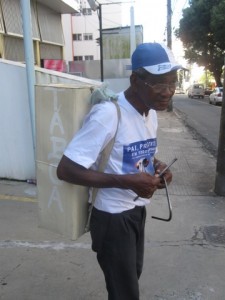
Photo © Michael Sommers.
The other day, as I was leaving my apartment and walking down the stairs, I heard the musical clang clang clang of a triangle being beaten. At the main stairway leading down to the street, I saw a taboqueiro standing on the steps, a thick silver triangle around his wrist. Reaching deep into the metallic container that was hoisted, knapsack-style, onto his back, he pulled out glistening plastic bags filled with long, cylindrical tabocas, and handed them to my neighbor, Roskildes (undoubtedly, a treat for the latter’s two identical twins, Dri and Dré, who were due back from nursery school at any minute).For years now, I’ve heard taboqueiros’ insistent triangle-ing, and witnessed their steady marching along sidewalks and across beaches in search of hungry customers. However, I must confess (somewhat shamefully) that I’ve never, ever sunk my teeth into a taboca.
The tabocas – resembling cinnamon sticks on steroids – beckoned to me, as did the taboqueiro himself.As I stopped to observe the transaction between the taboqueiro and my neighbor – during which three bags, each containing a quartet of tawny, delicate biscuits were exchanged for a mere R$5 – I decided that it was high time to atone for my sins of omission. The tabocas – resembling cinnamon sticks on steroids – beckoned to me, as did the taboqueiro himself, Florival, who announced that he’d been hawking tabocas up and down the streets and sands of Salvador for exactly 41 years.
A traditional street snack throughout the Brazilian Northeast, tabocas (as they are known in Bahia; in other regions they are called biju or cavaco chinês) resemble cigarettes russes (although, in this case, a cigar is a more apt comparison), but the inclusion of chocolate, vanilla, and cinnamon accounts for a color that is darker and a flavor that is richer. The name “taboca” is Tupi and refers to a variety of native bamboo that has traditionally had a wide range of uses amongst Brazil’s various indigenous groups. Later, taboca also became a slang term for the typical flutes or fifes, fashioned out of bamboo, which are played by musicians of the geographically arid, but culturally rich Northeastern Sertão.
As for my tabocas, when I expressed concern they would be crushed by the contents of my already overstuffed bag, Florival didn’t miss a beat – with an elegant flourish, he whipped out a wrinkled plastic supermarket bag from his pocket and offered it to me as I handed over my money.
He needn’t have bothered. By the time, I’d walked two blocks, all four tabocas were safely in my stomach.